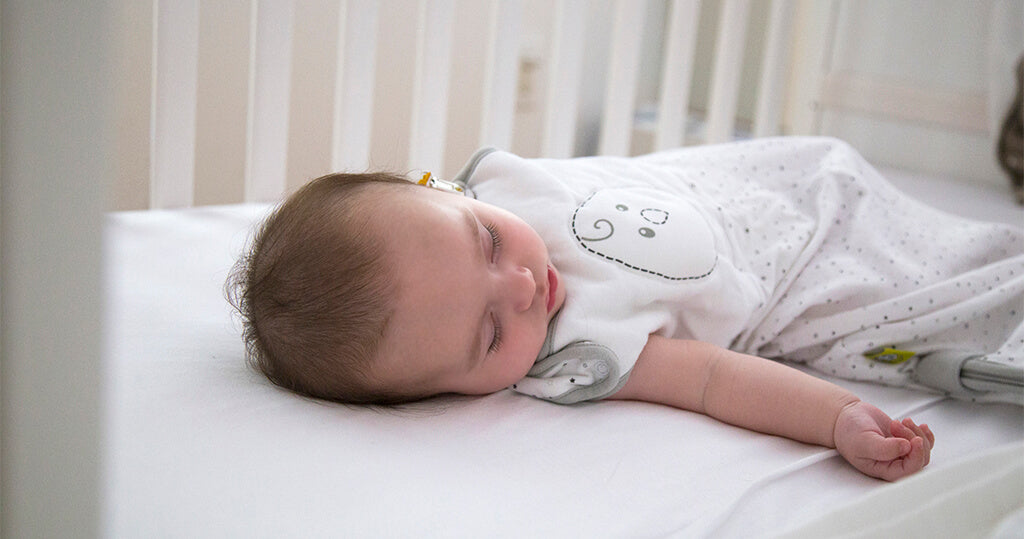Shopping Cart
Dream feeding baby might just be the solution to helping your child sleep through the night! The concept is interesting - you rouse your baby just enough to get them to take a feeding while they’re still asleep. It can be a way to help you maintain your baby sleep schedule and prevent sleep regression.
However, as with all developmental stages, there comes a time to transition away from this practice. Knowing when to stop dream feed is crucial for your baby's growing independence and evolving sleep habits.
In this comprehensive guide, we delve into everything you need to know about dream feeding - from when to start dream feeds to recognizing the right time and methods to gently phase it out, ensuring a smooth transition for your little one.
What is a Dream Feed?
A dream feed is basically exactly what it sounds like: you’re feeding your baby while they are still dreaming. More specifically, a dream feed is when you feed your baby while they are still asleep by gently rousing your baby enough to feed or nurse them in an effort to reduce middle-of-the-night wakings and feedings.
Usually, you would do a dream feed sometime between 10pm and midnight. Parents choose the time of dream feeding based on when they go to bed themselves and what seems to work the best for their baby.
The idea is that if you dream feed your baby (without fully waking them) before you go to bed, they will be full enough to sleep a longer stretch at night and/or until the early morning, which means you could potentially avoid a 2:30 or 3:30am wake up!

Why Can Dream Feeding be good for your baby (and you)?
Many moms find that a dream feed helps their baby sleep for longer stretches through the night, which results in more rest for both baby and mom! According to Dr. Harvey Karp, author of Happiest Baby on the Block, research has shown that introducing a dream feed around 11pm reduces night wakings among 3-month-olds, which is the ideal time to start a dream feed.

Once babies reach 3 to 4 months of age, they’ll eat 8-12 times throughout a 24-hour period, and most are capable of going 7 to 8 hours without a feed.
Many babies will still wake up multiple times for a feed out of habit, since as a newborn, they were fed more frequently to keep their tiny stomachs full.
Until you’ve weaned night time feedings, your baby won’t be sleeping through the night. But even after they reach the point when they can go a long stretch without a feed, if their last feed is between 7 and 8pm before bed, and they get 7-8 hours of sleep, that puts them at waking between 2:30 and 3:30am for a night feed.
Many babies, depending on their age, will wake up a second time around 5:30, which means your schedule might look a little something like this:
Without a dream feed
6:30 P.M. |
Feed your baby before putting them down for bed |
7:30 P.M. |
Baby goes to sleep |
11:00 P.M. |
You go to sleep |
1:30 A.M. |
Baby wakes up for a feed |
2:30 A.M. |
Finish feed, settle baby back to sleep |
3:00 A.M. |
You fall back asleep |
5:30 A.M. |
Baby wakes up for another feed |
6:30-7 A.M. |
Finish feed & maybe get baby back to sleep...but it's already time for you to start your day! |
Alternatively, if their last feed is at 11pm, before you go to bed, and they have 7-8 hours of sleep, they’ll be waking up around 6am. Meanwhile, you’ve had a night of uninterrupted sleep as well!
With a dream feed
6:30 P.M. |
Feed your baby before putting them down for bed |
7:30 P.M. |
Baby goes to sleep |
10:30 P.M. |
Dream feed |
11:00 P.M. |
You go to sleep |
2:30 A.M. |
Baby wakes up for a feed |
4:00 A.M. |
You fall back asleep |
7:30 A.M. or later |
Baby wakes up, you feed & start your day! |
Some babies might still wake at 3am out of habit, if they’re used to usually being fed at that time. If you do a dream feed at 11pm, as that's when you go to bed, and they wake around 2:30-3am, try to help your baby get back to sleep without a feed. Even if you can push it another hour and you feed them at 4am instead, you can keep pushing the second feed later over time until you get to your desired wake up time!
The Zen Sack can be helpful in weaning and eventually dropping the second night time feed, and in reducing night wakings in general. Because of its weighted center, the Zen Sack provides the same comfort and security of your hand resting on your baby’s chest, which can help them soothe back to sleep after that 3am wake up and break the association of feeding and/or being held.
Many moms have seen success in combining a dream feed with the use of their Zen Sack or Zen Swaddle to get their baby sleeping through the night.
|
|
The Zen Sack™: can help your baby sleep
|
Getting more sleep is no doubt the most attractive benefit of a dream feed, but it’s not the only one! Feeding or nursing your baby while they are still asleep also lessens the risk of an association forming.
As we mentioned, weaning nighttime feedings is an important step to getting your baby to sleep through the night (remember, you should only decrease feedings when your baby is developmentally ready as determined by your doctor), but it can be very difficult to break the sleep association of feeding to get back to sleep.
However, since a dream feed is done while your baby is still sleeping, no association will form.
Think of a dream feed as acting proactively instead of reactively. You feed your baby before they wake, instead of feeding them once they’ve already woken up and need to be soothed to go back to sleep.
Additionally, doing a dream feed means your baby won’t get distracted like they might during feeding while they’re awake. Dream feeding allows them to focus only on feeding and ensures that they get the proper amount of food they need per day.
Should I do a Dream feed?
How do I know if dream feeding is right for me and my baby? It’s like that old saying - you’ll never know unless you try!
The Baby Sleep Site mentions that a dream feed could be problematic for some babies, but notes that there is usually no harm in trying.
Other sleep consultants, like - Tizzie Hall, A.K.A the “International Baby Whisperer”, highly recommend a dream feed:
From the experts“The reason I recommend the dreamfeed, is to try to avoid you having to get up more than once in the night. When your baby is about eight weeks old, I recommend the dreamfeed at 10:30 at night. If you followed the routine but didn’t have the dreamfeed, your baby would go to sleep at 7pm and maybe wake between 11pm and 1am for the next feed. Let’s say your baby woke at 1:30am, you would get up and feed your baby. Maybe your baby would be back in bed asleep at 2:30am, but he might wake again at 5:30am for another feed. Then, by the time you have him asleep again, it would be time to get up and start the day. With the dreamfeed, your baby may sleep until let’s say 2am and then when back in bed; he is more likely to sleep until 7am. This means you have only had to get up once in the night." - Tizzie Hall, Director of Save Our Sleep |
If you or your baby falls into one of the following categories, you should consider trying a dream feed:
- Your baby is past the newborn stage (2 to 3 months or older), and can now go longer stretches without a feed.
- Your baby doesn’t feed enough during the day or gets easily distracted while feeding, and you’re concerned she might not be getting enough food.
- Your baby is overcoming a cold/illness and needs to maintain their hydration.
- You are breastfeeding and your breasts feel full, making you uncomfortable.
- You're having trouble helping baby sleep through the night.

Dream feeds do not work for every baby, but they do work for many! Moms who have seen success with it, encourage any new mom to give it a go.
When to start dream feeds
Before we guide you through how to actually go about dream feeding baby, we want to talk about when to start dream feeds in the first place.
In the early weeks, newborns require frequent feedings due to their small stomach capacity. It’s during this phase that setting a foundation for a feeding routine becomes essential.
As your baby grows, typically around the 3 to 4-month mark, their stomach capacity increases, allowing them to take more milk at each feeding and go longer between feedings.
This is often the ideal time to introduce dream feeds. It’s a transitional period where babies start developing a more predictable sleep pattern, making it a prime opportunity to gently extend the length of their sleep at night.
The Complete Guide to Dream Feeding Baby
If you’re ready to reap the benefits of dream feeding, we’ll walk you through the simple steps below. It’s not nearly as difficult as you may think!
Step 1: Rouse your baby without fully waking them up.
Your baby will need to be alert enough to take your breast or a bottle, but you want to be extra careful not to fully wake them, which could lead to a cranky baby and throw the whole night off. For some babies, all you need to do to stir them is gently take them out of the crib and position them to feed.
Unlike sleep training methods that encourage babies to sleep longer stretches without eating, dream feeding doesn’t interfere with a baby’s normal need to be fed at night. It just tweaks your baby’s schedule a bit so that babies and parents are on a more similar sleep schedule. -Healthline
Step 2: Feed them!
Continue on like you would during a normal feed. Make sure their head is slightly elevated, as feeding while lying flat poses a risk of choking. If you’re bottle feeding, you can usually wiggle the bottle into the baby’s mouth to initiate suckling.
If you’re breastfeeding, get your baby to latch on to start suckling. If you’re having trouble getting them to take the breast or bottle, they probably aren’t awake enough.
How many mls are appropriate for a dream feed?
Generally, you should aim to have your baby drink as much as they would during a normal feed while dream feeding. The amount that a baby should be eating every feed is based on their age.
Newborns generally drink about 45-90 milliliters every 2-3 hours. At 2 to 3-months-old your little one will be drinking about 120-150 milliliters every 3-4 hours.
From 4 to 5-months-old they could reach as much as 180 milliliters per feed. And by 6-months-old most babies are up to about 180-230 milliliters every 4 to 5 hours.
Should I leave my baby swaddled for the dream feed?
In most cases, yes. Leave your baby swaddled. You want to stimulate them as little as possible - only enough to get them to feed. Un-swaddling might wake them up.
Our weighted baby swaddle will also help baby sleep longer because of its gently weighted chest and sides that mimic your touch. However, if your baby is too drowsy to feed, un-swaddling might help them wake up enough.
You can learn more about the types of swaddles in our blog and the benefits of swaddling. We have zipper swaddles, transitional swaddles, bamboo rayon fabric swaddles, and even weighted sleep sacks.
What if my baby is too drowsy and won’t eat during the dream feed?
Some babies will take a little more stimulation than others to get them awake enough to feed, just make sure you don’t rouse them too much, or they’ll completely wake up! Here’s some tricks you can try rouse them enough to get them to feed:
- Run a wet wipe or cloth across his cheek
- Rub or tickle the bottom of his feet or chin
- Put some milk on his lips
If those don’t work, put your baby back down. You can try again briefly a little while later, if you’re still up. If it doesn’t work, don’t force it. Like they say, “never wake a sleeping baby.” - you don’t want to run the risk of having a cranky baby all night because you accidentally woke them up mid-slumber.
If you try without success for a few nights, give it a rest for a couple weeks and come back to it.
When to stop dream feed?
This is one of the most common questions we get asked - when to stop dream feed? The decision to phase out dream feeding is largely dependent on your baby's sleep patterns and developmental milestones.
Typically, when a baby starts sleeping through the night consistently, without waking for a second feed around 3 am, it might be time to consider easing out of dream feeding. This usually occurs around the age of 9 months, but it can vary as each baby's sleep habits and needs are unique.
To transition away from dream feeding, you can gradually shift the feeding time earlier each night. For example, if you usually dream feed at 11 pm, you might try moving it to 10:45 pm, then 10:30 pm over the course of several nights or weeks. This gradual change helps your baby adjust without causing significant disruption to their sleep routine.
However, it's important to be attentive to your baby's response to this change. If your baby starts waking up earlier than usual or seems hungrier in the early morning, it could indicate that they're not yet ready to drop the dream feed. In such cases, it's advisable to return to the previous dream feed schedule and attempt to shift it earlier again after a couple of weeks.
Remember, stopping dream feeding is a process that requires patience and responsiveness to your baby's cues. It's also important to ensure that your baby is receiving enough nutrition during the day, as this can impact their nighttime feeding needs.
We have resources in our blog to help baby sleep through the night after you stop dream feeding baby. You can learn about when to start sleep training, sleep aids, and the ideal baby bedtime routine to prevent regressions once you stop dream feeding.
Do you change diaper when dream feeding?
You may be wondering - do you change diaper when dream feeding? Only if you feel it’s necessary. You’ll know best once you try a dream feed for a few nights.
Again, the idea is to stimulate your baby as little as possible. A diaper change might wake them up, so avoid it if possible. This sort of defeats the purpose of dream feeding.
However, if your baby wakes up a hour or two later because of a wet diaper, it might be necessary to do a quick change after the dream feed before putting them back down.
If you find your baby needs the diaper change after a dream feed, we’d recommend using the The Zen Sack. Its gently weighted center will help keep your baby calm and drowsy while you sneakily use the 2-way zipper to make a quick diaper change and a longer stretch of sleep!
 Sweeter Sleep Story“I love this[Zen] Sack and so does my 4 month old son! I ordered up a size so he would be able to wear it longer and it works perfectly! It is so soft and the zipper is perfect for late night diaper changes. Will definitely be using this for a while!" - Amazon Customer, 6/15/2017 |
Wrapping Up Our Guide on Dream Feeding Baby
There you have it - everything you need to know about dream feeding baby. From when to start dream feeds to when to stop dream feeds, navigating diaper changes, and actually dream feeding your child - we help you feel confident in implementing this tactic in your child’s sleep routine.
You can find more tips on improving your kids sleep in our blog, including how often to feed newborn at night, wake windows by age, home remedies for teething baby at night, swaddle vs sleep sack, what to dress baby in for sleep, benefits of swaddling, what to wear under sleep sack, when to transition from sleep sack to blanket, when to stop using sleep sack, what age should a child sleep in their own room, and more.
At this point, though, it’s time for you to think about how you can implement a baby dream feed into your child’s sleep routine. Best of luck!



Hello!
I tried dream feeding for the first time last night. My son is 14 weeks old and usually goes to sleep between 7 and 7:30 pm, then wakes around 1 am and around 4/5 am. He falls asleep on his own (In his bed without any carrying around, feeding to sleep etc) in the evening and usually without problems at night too. His milk intake is about 2/3 day and 1/3 at night.
I dream fed him at 10 pm last night, but he still woke shortly before 2 pm and then again between 4 and 5. I fed him a normal bottle the first time which he drank almost fully, and then one with only half as much milk powder as recommended the second time because i was afraid he’d not be hungry in the morning and the milk intake would wander more into nighttimes which is exactly what I do NOT want obviously.
I thought he might probably take some time to adjust, so to speak to “delete” his usual waking times. Is that so? Or is he probably one of the babies that don’t go with the dream feeding? How long would I try till I’d see results if there were any? And what do I do in the meantime? Try to put him back to sleep without a drink, but if he doesn’t go back to sleep? Rather give a bottle with half a portion of milk powder, to fill his stomach and/or eliminate the possibility of thirst, but still have him hungry(er) during daytimes?
If I could get any tips it’d be great. :-) Thanks in advance!
Victoria on
Should I switch breasts during a dream feed if my LO falls back into a deep sleep and stops feeding from the current breast?
Sonni-Ann on